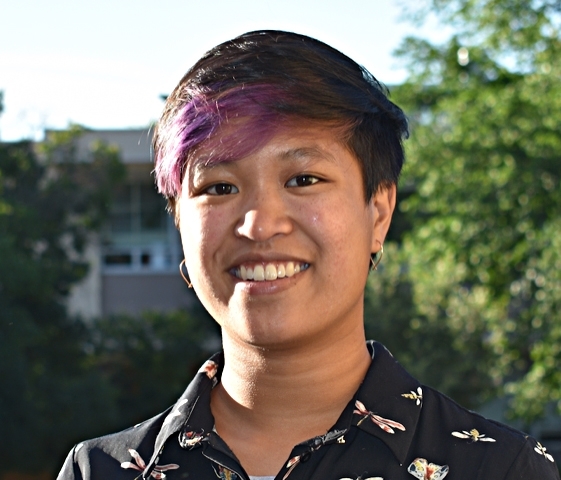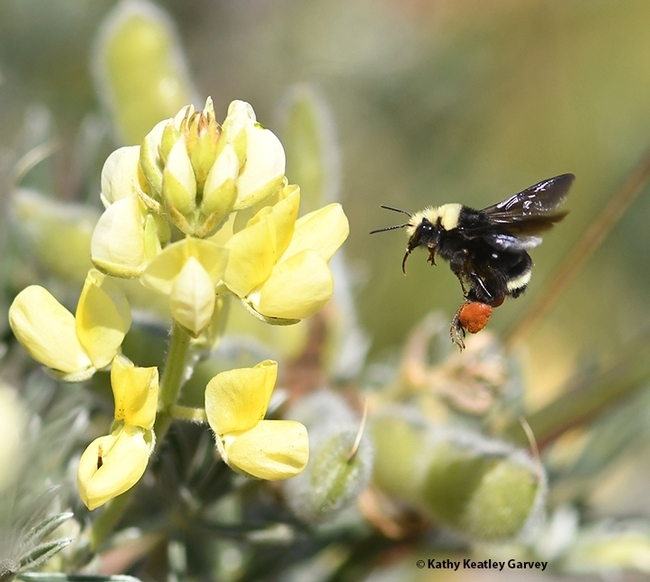- Author: Kathy Keatley Garvey

Kathy Keatley Garvey, communications specialist for the UC Davis Department of Entomology and Nematology, wrote the news article on "An Amazing Doctoral Opportunity Few Receive,” in March of 2021. The article won the “writing for newspapers” category. (See https://bit.ly/3MfuaLn)
“When five-year-old Rebecca Jean “RJ” Millena entered her kindergarten class in Concord, Calif., she immediately settled on a career choice: entomology,” Garvey began.
“An ‘About Me' poster hanging in her childhood home in Concord confirms it: ‘When I grow up, I want to be an entomologist.'
“She did and she is.”
Millena, who over a two-year-period worked as a student researcher in the laboratory of UC Davis distinguished professor Jay Rosenheim, studied the bizarre Strepsiptera endoparasites that attack their hosts, the Ammophila (thread-waisted) wasps. Millena went on to receive her bachelor's degree in entomology in 2021, and a rare four-year, full-ride doctoral fellowship from the American Museum of Natural History.
While at UC Davis, Millena studied Ammophila specimens at the Bohart Museum of Entomology, which houses a worldwide collection of more than 30,000 Ammophila (among the Bohart's eight million specimens). As larvae, members of the order Strepsiptera, known as “twisted wings,” enter theirs hosts, including wasps and bees, through joints or sutures.
Millena drew information and inspiration from UC Davis alumnus Arnold Menke, a global authority on Ammophila and author of "The Ammophila of North and Central America (Hymenoptera, Sphecidae).
“Strepsiptera are very unusual among parasites in that the parasite is visible on the outside of the host's body,” Rosenheim explained. “The head of the parasite protrudes between the sclerites on the abdomen. Looking across a growing list of species, RJ has shown that Ammophila species where mothers have more extended contact with their young--because they provision their nests with many, small caterpillars instead of one giant caterpillar-- are at much greater risk of acting as inadvertent vectors of strepsipteran parasites to their young.”
“RJ has shown that this one feature explains something like 90 percent of the total variation across Ammophila species in the risk of parasitism,” Rosenheim said. “Ecology virtually never works in such a predictable way; this is one truly exceptional counterexample of nature being highly predictable. Anyway, RJ's work shows that sometimes parental care can be a double-edged sword; we usually think of parental care as providing enhanced protection of offspring from predators and parasites. In this case, it proves to be the reverse.”
Also quoted in the news story was Lynn Kimsey, director of the Bohart Museum and a UC Davis distinguished professor of entomology: “RJ is one of those rare students that is focused, task-oriented and simultaneously creative. She was great fun to have working in the museum.”
Entomology Photo Series Award
Garvey also won the ACE silver award (second-place) for her picture story on “The Flight of the Bumble Bee,” posted June 14, 2021 on her daily (Monday through Friday) Bug Squad blog on the UC Agriculture and Natural Resources website. (See https://bit.ly/3xuoPLN)
Garvey captured in-flight images of a yellow-faced bumble bee, Bombus vosnesenskii, foraging on lupine at Bodega Bay. In her blog, she drew attention to two books: California Bees and Blooms: A Guide for Gardeners and Naturalists (Heyday, 2014), the work of University of California scientists Gordon Frankie, Robbin Thorp, Rollin Coville and Barbara Ertter; and Bumble Bees of North America: An Identification Guide (Princeton University, 2014), co-authored by Thorp (1933-2019), a UC Davis distinguished emeritus professor of entomology.
ACE, an international association of communicators, educators and information technologists who focus on communicating research-based information, will present the communication awards at its 2022 conference, set June 12-14, in Kansas City, MO.


- Author: Kathy Keatley Garvey

Senior museum scientist Steve Heydon will give a 15-minute presentation on parasitoids and the group that he studies--the jewel wasps (Pteromalidae) from 2 to 2:15. He is a global expert on jewel wasps.
Rosemary Malfi, a postdoctoral fellow in the Neal Williams lab in the UC Davis Department of Entomology and Nematology, will present a mini talk from 3 to 3:15 on some of the parasitoids she worked with while completing her doctorate. She did extensive work on the interaction between conopid flies and bumblebee hosts.
The event is free and open to the public. A family arts and crafts activity is also planned.
"An insect parasitoid is a species whose immatures live off of an insect host, often eating it from the inside out," said Tabatha Yang, education and outreach coordinator. "It is part of their life cycle and the host generally dies. This sounds like a weird way to make a living, but there are more species of parasitoids than there are insects with any other kind of life history.”
Wasps, flies and beetles are parasitoids to many different insect groups.
Another group of parasitoids that will be highlighted will be the Strepsiptera, or twisted-wing parasites, an order of insects that the late UC Davis entomologist Richard M. Bohart (1913-2007), for whom the museum is named, researched for his doctorate in 1938. An entire family of Strepsiptera, the Bohartillidae, is named in honor of Professor Bohart.
The Bohart Museum, directed by Lynn Kimsey, professor of entomology at UC Davis, houses a global collection of nearly eight million specimens. It is also the home of the seventh largest insect collection in North America, and the California Insect Survey, a storehouse of the insect biodiversity. Noted entomologist Richard M. Bohart (1913-2007) founded the museum.
Special attractions include a “live” petting zoo, featuring Madagascar hissing cockroaches, walking sticks and a rose-haired tarantula named “Peaches.” Visitors are invited to hold the insects and photograph them.
The museum's gift shop, open year around, includes T-shirts, sweatshirts, books, jewelry, posters, insect-collecting equipment and insect-themed candy.
The Bohart Museum's regular hours are from 9 a.m. to noon and 1 to 5 p.m. Mondays through Thursdays. The museum is closed to the public on Fridays, Saturdays and Sundays and on major holidays. Admission is free.
More information on the Bohart Museum is available by contacting (530) 752-0493 or emailing bmuseum@ucdavis.edu or Tabatha Yang at tabyang@ucdavis.edu.


